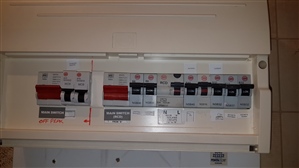Sparkingchip:
If you did a 5x test and sent 150 mA to earth without tripping the the upfront RCD then as Bod says it’s either time delayed or faulty, alternatively it is 300 mA, an ELCB or doesn’t exist.
A 30 mA test will often take 100 mA RCD out if it’s not time delayed and the test button on the 30 mA RCD can take both of them out.
The tests were a 1/2 and 1X test, as I wanted to lessen the risk of taking out the inaccessible R.C.D., if there is one, in the locked brick supply shed. I was more interested in checking over sensitive R.C.D.s at the van hook up and inside the van. They both tested o.k. for functionality.
Kelly Marie Angel:
Morning all how's it going? Sparkingchip i thought an ELCB was an RCD by another name? Or am I wrong?
Hello Kelly, an E.L.C.B. is an earth leakage circuit breaker. Here is a JW video about the now obsolete Voltage Operated Earth Leakage Circuit Breaker (V.O.E.L.C.B.).
They normally tripped well before the installation earthed metalwork reached 50 Volts, say at 30 to 40 Volts max.
The earthing lead and rod were essential to proper operation. The rods sometimes rotted away or the earthing lead was pruned through thus making the device useless. I still find working models installed but they are getting rarer nowadays.
A family were receiving shocks from installation metal work in an old holiday chalet here. The V.O.E.L.C.B. had no reliable connection to its earth rod, so thus did not work. Very dangerous.
https://www.bing.com/videos/search?q=youtube+JW+VOELCB&docid=608039490843982793&mid=E9C7C600CA59C2530BDFE9C7C600CA59C2530BDF&view=detail&FORM=VIRE
Edit. Add, What JW fails to say is that if the very long metal undergrounf water pipe is connected as his diagram shows the 15 Amp immersion heater fuse will automatically blow thus quickly clearing the fault. The V.O.E.L.C.B. will still limit the installation Voltage to less than 50 Volts in any case.
A big fault with them was that a fault next door causing a water pipe to reach say 3o to 40 Volts would trip off your V.O.E.L.C.B. which would be a nuisance.
If the earth electrode was not positioned out of the resistance area of other buried metalwork say like the underground metal water pipe, the coil would be effectively shorted and would not detect the fault Voltage of up to 50 Volts.
One good thing about the design of the V.O.E.L.C.B. was that the test switch confirmed the good condition of the device plus the earthing lead and earth rod as well. A break in the connection to the earth rod would not allow the device to trip if the test button was pressed with the Crabtree design.
Z.

perspicacious:
I'm going for 500 mA RCD in there Andy!
Regards
BOD
Quite possibly, I tried it at 30 mA and 150 mm without getting it to trip, so I fitted a double pole B40/30 mA RCBO to the shower circuit and wrote an advisory note.
It is earthed TNCS-PME.
We're about to take you to the IET registration website. Don't worry though, you'll be sent straight back to the community after completing the registration.
Continue to the IET registration site